5 min read
5 Time Management Techniques Leaders Can Teach Struggling Employees
Poor time management isn’t an isolated issue. It almost always spills over into other areas of an employee’s life on the job. It impacts everything...
4 min read
 Michelle Bennett
:
Jul 20, 2023 5:00:00 AM
Michelle Bennett
:
Jul 20, 2023 5:00:00 AM

How many times have you wished there were more hours in the day to get everything done? Unfortunately, if you feel this way at work, you’re not alone. Only 20% of employees feel they have their workload under control.
While some aspects of how you spend your time at work and your workload are out of your control, there are time management strategies and tools you can use to track, prioritize, and formulate a plan to be more in control of where you spend your time.
Time is a finite resource; you can’t get more of it, so you’d better optimize it. That’s why we’ve compiled our favorite time management strategies with corresponding tools to take control of where you spend your time.
The exercise of writing down tasks to visualize and record what needs to be done can help increase your productivity and decrease stress. Also, as you cross each item off your list, you get a sense of accomplishment which gives a boost of motivation to continue completing more items.
While a to-do list may feel like one of the most obvious time management strategies, in a 2022 survey of 500 employees, just 33% of people said they use a to-do list to manage their time and tasks.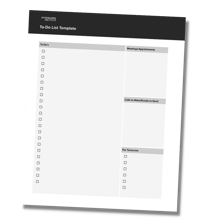 To help you easily write down your tasks as soon as you think of them and cross off the completed ones, use this free editable to-do list template. With a to-do checklist, a section for meetings and appointments, reminders on calls or emails to respond to, and a section to set yourself up for success for the next day, this time management tool should be a daily go-to for taking back control of your day.
To help you easily write down your tasks as soon as you think of them and cross off the completed ones, use this free editable to-do list template. With a to-do checklist, a section for meetings and appointments, reminders on calls or emails to respond to, and a section to set yourself up for success for the next day, this time management tool should be a daily go-to for taking back control of your day.
Distractions at work are almost impossible to avoid. In fact, 98% of respondents in one study said they’re interrupted at least 3 to 4 times at work a day. While you cannot prevent all interruptions, you can ensure you have a plan to make the most of it when you have focused time.
Time blocking is a time management strategy that divides your day into chunks of time dedicated to specific tasks. By allocating time to such activities, completing projects, checking emails, attending meetings, and returning phone calls, when 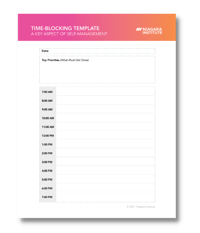 you’re focused on one activity, you remove all other distractions.
you’re focused on one activity, you remove all other distractions.
By removing the most common distractions, such as emails (26%), phone calls/texts (55%), co-workers (27%), and surfing the internet (41%), the time you have dedicated to each specific task becomes your sole focus, making you more productive, and hopefully, freeing up your time. Download your copy of the time-blocking template here.
Former U.S. President Dwight Eisenhower created the time management strategy that was later coined the Eisenhower Matrix or Priority Matrix. He used this simple yet powerful time management tool to help him prioritize the many issues and tasks he faced daily. Many years later, Stephen Covey made this time management strategy mainstream in his widely-popular book, The 7 Habits of Highly Effective People.
The concept is simple, on a two by two matrix, categorize all of your to-do’s into one of these four categories:
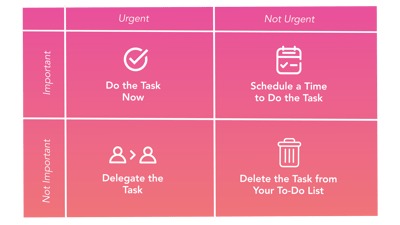 Top Left: Urgent and important
Top Left: Urgent and importantThese are the tasks you’ll do immediately
These tasks you’ll schedule to do at another time
If you have authority, these are the tasks you will delegate to someone else
These are tasks you will delete from your list
To help you categorize your tasks, keep in mind urgent tasks are ones that you deem require a quick repose, whereas important tasks are ones that move you closer to achieving your long-term goals and vision. Dwight Eisenhower had some sage advice so all tasks don’t end up in the top right corner (urgent and important), “What is 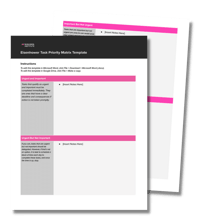 important is seldom urgent, and what is urgent is seldom important.”
important is seldom urgent, and what is urgent is seldom important.”
Try using our editable time management tool, the priority matrix, to categorize your daily tasks to visualize what truly needs your attention.
Despite the funny name of this time management strategy, it can be your secret weapon for getting things done you’ve been putting off. The concept created by self-development guru Brian Tracy got its name from Mark Twain, who once said, “Eat a live frog first thing in the morning, and nothing worse will happen the rest of the day.”
The concept is simple; you start your day by tackling your most challenging tasks first before you have time to think about them and come up with excuses. The idea is these tasks are complex and difficult, requiring your most significant energy and focus. Therefore, they should be done first, before all your other tasks.
When this concept is used across a team or organization, the phrase “Eat the frog” becomes synonymous with doing critical tasks requiring your undivided attention. For example, in one organization I worked with where this time management strategy had become part of the company vocabulary, it was not uncommon to hear someone saying, “I’ve got to go eat the frog.” This told their colleagues to minimize 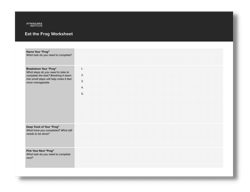 interruptions as they were focused on completing a difficult task.
interruptions as they were focused on completing a difficult task.
To help you eat your frog, we’ve created a time management tool where you can record your frog, break it down into steps, track what you’ve completed vs. what still needs to be done, and plan on where you will pick up on the task next time.
You’ll never have a shortage of things to do at work on your to-do list. However, have you taken the time to truly evaluated all the tasks on your list and see if there is anything you should stop doing or do differently to free up your time?
Assessing how you’re spending your time can be critical to maximizing your effectiveness. To help you do this, try using the time management tool, the start-stop-continue template. Essentially, it is an evaluative and brainstorming process where you look at what you should start, stop, or continue doing. Complete the template by asking yourself the following questions about your tasks at work:
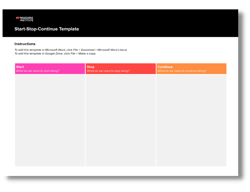 Sometimes the outcome of this exercise results in simple changes and a small number of actions that help you move forward, which otherwise would not have happened without taking a critical look at how you’re spending your time.
Sometimes the outcome of this exercise results in simple changes and a small number of actions that help you move forward, which otherwise would not have happened without taking a critical look at how you’re spending your time.

5 min read
Poor time management isn’t an isolated issue. It almost always spills over into other areas of an employee’s life on the job. It impacts everything...
![Executive Assistant Skills Assessment [2024]](https://www.niagarainstitute.com/hubfs/Executive%20Assistant%20Skills%20%20%281%29.png)
5 min read
Have you ever asked yourself what exactly makes a great executive assistant (EA)? While there are many ways to answer this question, one thing is...

8 min read
As Henry Mintzberg, Canadian academic and author on business and management, put it, “Management is, above all, a practice where art, science, and...